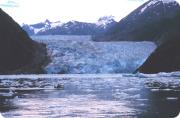Radio Program
Our regular Science and the SeaTM radio program presents marine science topics in an engaging two-minute story format. Our script writers gather ideas for the radio program from the University of Texas Marine Science Institute's researchers and from our very popular college class, Introduction to Oceanography, which we teach to hundreds of non-science majors at The University of Texas at Austin every year. Our radio programs are distributed at to commercial and public radio stations across the country.
Beds of grass are great natural habitats -- on land or in the sea.
They provide food, hiding places, and hunting grounds. They stabilize the soil, and filter out pollutants.
Seagrass beds, in fact, are some of the most productive habitats on Earth. Small fish and shellfish hide among the blades. Larger fish gobble up these small fry. Birds eat the fish, as well as some of the grass. And other land animals eat the birds and their eggs.
A study of conditions over the last half-century, though, shows that the amount of freshwater flowing into these northern seas is increasing. Scientists are monitoring the flow to see how it impacts both oceans and land.
A team of researchers tallied data on the flow of freshwater for all major sources -- rivers, rain, and melting ice.
Every time you take a breath, most of what you inhale is nitrogen, because it makes up about four-fifths of the air.
Nitrogen is an important nutrient, and a crucial component of some of the basic building blocks of life. Yet the nitrogen in the air is in a form that complex organisms like people can’t use. It has to be altered through a dynamic process called the nitrogen cycle. This cycle passes nitrogen from one organism to another, so the element is a sort of “currency of life.”
A tasty fish that’s not all that well known could become a seafood staple in the years ahead.
The fish is called cobia or ling. It’s found in fairly warm waters around the world, including along the American Atlantic and Gulf coasts.
Cobia grow up to six feet long, and can weigh 50 to 100 pounds. And its firm, white meat tastes good.
Cobia hasn’t caught on commercially, though, because they travel alone or in small groups, so there’s no way to catch them in large quantities.
The mighty Mississippi River dumps a hundred cubic miles of water into the Gulf of Mexico each year.
The Amazon River dumps about 10 times that amount into the Atlantic. And thousands of other rivers and streams around the world contribute even more to the world’s oceans.
Tropical coral reefs are some of nature’s most colorful and diverse ecosystems. They provide Technicolor displays unlike those found anywhere else on Earth.
But many coral reefs aren’t looking so good these days. Like a Hawaiian shirt doused with Clorox, they’ve had the color bleached right out of them. And that can damage or even kill an entire reef system. In the last few years, in fact, bleaching events have decimated corals in the Caribbean, the Galapagos Islands, and in Australia’s Great Barrier Reef, to name a few.
Much of the American coastline is a transition zone -- not an abrupt boundary between land and sea, but regions where both domains exert their influence. These regions are known as estuaries. They’re enclosed areas like bays and marshes where freshwater from the land mixes with saltwater from the sea.
One of the many futuristic technologies in “Star Trek” was the tricorder -- a portable device that let crew members quickly scan the environment around them.
Present-day scientists aren’t waiting for the 23rd century to build such devices, though. They’ve already put together tricorder-like gizmos for medicine, materials science, and other fields. And today, marine scientists are designing their own tricorders.
When they add fertilizers to their fields, farmers from Montana to Pennsylvania and points farther south can increase crop production, helping to feed a hungry world. But those same fertilizers can eventually make their way into the Gulf of Mexico. There, they may actually kill off the fish and shellfish, creating a “dead zone” along the Gulf Coast.
From “Flipper” to Sea World, we’ve all heard the chirps, trills, and other sounds produced by bottlenose dolphins. But the sounds are more than just entertainment. They help the dolphins locate prey, stay close to family members, and warn others of danger. And certain types of sounds may serve as “names” that identify individual dolphins.


